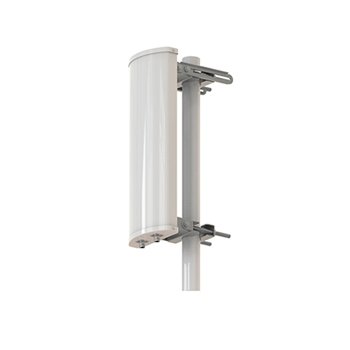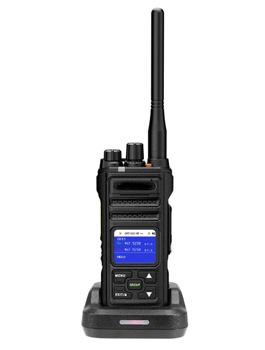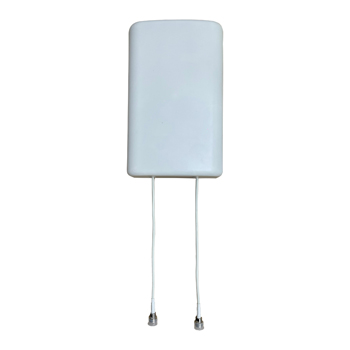
Ultra-Wide Band (UWB) antenna offers coverage across a broad frequency spectrum while maintaining its power consumption at a relatively lower level. This enables UWB antenna to effectively contribute to variety of applications across a range of industries. This article aims to provide an overview of UWB antennas focusing on their functionality, applications, and associated advantages and challenges. Furthermore, it also explores key factors to consider when selecting a UWB antenna in order to serve as a guide to ensure the antenna’s optimal performance.
Table of Contents
ToggleUnderstanding UWB Technology: An Introduction
Federal Communications Commission (FCC) defines Ultra-Wide Band (UWB) technology, as any wireless technology that occupies a bandwidth wider than 500 MHz or a fractional bandwidth greater than at least 20% of the carrier frequency. Typically ranging from 3.1 GHz to 10.6 GHz, UWB stands out from other similar technologies by its short pulse signal transmission capability. Due to this characteristic feature, UWB is able to process high data rates amidst low power consumption while maintaining exceptional precision in terms of ranging and localization.
The high precision and low interference features of UWB technologies make it a popular choice across a variety of industries. In consumer electronics, UWB is applied to enhance wireless connectivity for smartphone and high-speed media streaming. In military applications, UWB is effective in secure communications and advanced imaging systems. Furthermore, UWB is an innovative element in terms of its role in facilitating improved connectivity across IoT devices.
What is a UWB Antenna and How Does it Work?
UWB antenna is designed to ensure the efficient use of the broad bandwidth considerations defined by the FCC. In addition to having a broader bandwidth, these antennas differ from conventional narrow bandwidth antennas in their ability to transmit short duration pulses. This feature enables UWB antenna to effectively handle high data rates at a relatively low power consumption and precise positioning capabilities.
The working mechanism of a typical UWB antenna involves a UWB transmitter which generates less than nanosecond pulses. The short pulses generated by the transmitter correspond to a wider frequency bandwidth characteristic of UWB antennas following the principles of Fourier analysis. The pulses are then radiated as electromagnetic waves, and as they occupy a wide frequency range, they are able to travel with very little interference. At the receiver’s end, these short pulses are captured, and the information is extracted by using a matching filter or a correlator process.
Different Types of UWB Antennas
Ultra-Wide Band Antennas are an important element in constructing modern communication systems as they allow wide frequency bandwidth and versatility across a wide range of applications. Some of the most commonly found UWB antenna options are as follows,
Omnidirectional fiberglass UWB antenna
These antennas offer a uniform 360° horizontal field of coverage making them a great option for applications such as outdoor short-range communication systems and wireless sensor networks where consistent signal distribution is required. Furthermore, the fiberglass casing of the antenna makes it durable against several environmental factors such as UV radiation, moisture, and variations in temperature.
Panel UWB antenna
Panel antennas come in their characteristic flat, and rectangular design with directional field coverage. Therefore these antennas are effective for applications with higher gain and focused coverage such as indoor wireless networks, Distributed Antenna Systems (DAS), and direction- finding applications.
Monopole UWB Antennas
Monopole antennas include a single radiating element mounted above a ground plane. Even though simple in their design these antennas handle a variety of applications across a broad impedance bandwidth such as mobile devices and wireless communication systems where space is limited.
Dipole UWB Antennas
These antennas consist of two identical conductive elements mounted in opposite directions in order to form a balanced radiation pattern fostering a symmetrical coverage. The balanced radiation pattern of Dipole antennas makes them an effective solution for mitigating polarization mismatch and ensuring signal transmission reliability in dynamic environments. Additionally, dipole antennas are also a great choice for Multi Input and Multi Output (MIMO) systems operating in the UWB range due to their symmetrical structure.
Base Station UWB Antennas
These antennas are designed as fixed installations to ensure reliable connectivity across large-scale communication infrastructures such as cellular networks and wireless internet services. In order to handle various coverage requirements these antennas come in both omnidirectional and sectorized designs. The omnidirectional type is used in public spaces and rural networks where devices are spread across multiple directions. The sectorized type is mostly used in cellular networks where targeted coverage is critical for efficient network traffic management.
Applications of UWB Antenna
Internet of Things (IoT)
UWB antennas facilitate precise location tracking and secure communication across IoT devices. Some of the typical applications include keyless entry systems, secure vehicle authentication, and smart home automation. As UWB antennas feature a low power consumption they are used in energy constrained IoT devices for consistent efficiency. Additionally, as UWB antennas are able to coexist with other technologies without any significant interference these antennas can be easily integrated alongside existing IoT ecosystems.
Asset Management
In terms of asset management, UWB antennas enables real time tracking of equipment, tools, and inventory within and around the facilities. This is achieved by attaching UWB tags to assets, which allows organizations to monitor the asset’s location and movement with a centimeter level accuracy. The UWB-enabled precision tracking is important in reducing asset loss, optimizing utilization of assets and streamlining maintenance processes. As UWB can ensure reliable and robust performance even in challenging environments, it makes it an ideal choice for healthcare, manufacturing, and logistic related operations.
Telecommunications
High data rate and low latency featured in UWB antennas make them highly suitable for short range wireless communication systems. Therefore, UWB antennas can be used to support wireless monitors, camcorders, and file transfers to portable media players. However, despite its potential and ability to coexist with existing communication systems, UWB antenna usage in consumer telecommunication is far from being widely adopted due to the associated high initial costs.
Smart Logistics and Supply Chain Management
The ultra-wide band (UWB) antennas improve supply chain management by facilitating real-time tracking and visibility of the in-transit merchandise. Its pinpoint location tracking can lead to effective inventory control, reduced waste, and optimized logistics activities. Companies may be able to realize better coordination and efficiency throughout the supply chain, by combining UWB-based technologies that can result in better delivery times and a higher level of customer satisfaction, by integrating UWB antenna systems
Positioning, & Sensor (RTLS)
UWB antennas are most commonly used in Real-Time Location Systems (RTLS) as they can provide high-accuracy ranging and localization capabilities. Some of its applications include indoor wayfinding, asset localization, and staff localization. The ability of UWB systems to provide precise location in areas of high density makes them highly effective for applications where accurate location is required, such as hospitals, factories, and large commercial spaces.
Industrial Automation
In industrial settings, UWB antennas enable precise localization and communication between machines and systems. This enables real time coordination and synchronization of automatic procedures, all of which contribute to improved manufacturing efficiency and reduced human error. The robustness of UWB against multipath interference guarantees satisfactory performance in challenging industrial settings, enabling applications such as robotic motion, worker safety systems, and machinery monitoring.
Wireless Personal Area Networks (WPANs)
Ultra-wideband (UWB) based wireless personal area networks (WPANs) provide high throughput data transmission over short distances. Due to its high frequency bandwidth, UWB antennas enable large data transmissions with the lowest interference. Some of UWB-based WPAN applications include wireless USB connections, multimedia streaming between devices, cable replacement for the external inputs/outputs, etc. With low power consumption and high data rates, UWB provides an efficient short-range communication solution between mobile devices.
Advantages of UWB Antennas: Key Benefits
UWB antennas offer several advantages that make them a great solution to a variety of applications some of its key advantages are as follows:
High Data Rate
Thanks to the wide bandwidth they occupy, UWB antennas is highly suitable for transmission of large volumes of data over short distances. This allows data rates to reach several hundred Mbps or even Gbps depending on the application. The short-pulse UWBs are particularly beneficial for real-time applications that require low latency, like real-time games and augmented and virtual reality applications. Additionally, UWB antennas are increasingly being used in high-resolution imaging systems, where the large data bandwidth facilitates clear and high-quality imaging.
Low Power Consumption
UWB antennas requires extremely low power levels, typically in the microwatts range, which makes it incredibly efficient. Because of this low power profile, it is a critical element in wearable devices, wireless sensors, and IoT applications where optimal efficiency translates to optimal battery life. Besides, the low energy consumption also aligns with the contemporary energy-saving trends of smart cities industry and green buildings, effectively contributing to reducing carbon emissions of the wireless systems.
Precise Positioning and Ranging
UWB can provide location accuracy at the centimeter level, which is much better than the usual used Wi-Fi or Bluetooth technologies, which have meter-level accuracy. This level of precision is very useful in the context of hospitals for instance, where the precise positioning of medical equipment and people can be used to increase efficiency and safety. Also, in sports analytics UWB is applied for the precise tracking of player’s movements to improve the performance analysis and strategic planning.
Resistance to Multipath Interference
Multipath interference, typical of urban or indoor environments, leads to signal distortion. The ultra-short pulses and wide bandwidth of UWB, reduces the overlap of reflected signals in the time domain, preserving the signal quality even within turbulent settings. This makes UWB antenna an effective option for warehouses, factories, or city navigation systems that contain physical obstacles such as walls and machines, etc.
Coexistence with Other Wireless Technologies
The low power spectral density of UWB makes UWB antennas immune to other wireless technologies. For instance, in smart homes, UWB can be used in conjunction with Wi-Fi and Zigbee networks without any performance drop. Its ability to work very well with the existing wireless systems simplifies the integration of UWB into multifunctional devices making it an ideal option for hybrid systems in consumer electronics and industrial automation systems.
Enhanced Security
In many traditional wireless systems, signal strength is used to calculate distance, so the system is susceptible to relay station attacks where the attacker artificially amplifies signals to deceive the systems to open doors.
UWB counters this by the Time of Flight (ToF) and accurate ranging method in which the time that a signal needs to travel a given distance is measured and then multiplied by the speed of light to determine distance. Because time and the speed of light cannot be manipulated, the UWB offers a high level of protection against such manipulations. When a relay attack is attempted, the system identifies the tampering, verifies that the object is at a higher position, and remains locked, providing a very strong level of security.
Limitations of UWB Antennas: Challenges to Consider
Design Complexity
Designing UWB antennas is more difficult than designing narrowband antennas. The UWB antennas are expected to function optimally spanning a wide range of frequencies while maintain the same level of performance with respect to gain, impedance matching and radiation patterns. Simultaneously, complying with such criteria often involves high-level design methods, such as multi-layer structures, sophisticated feed systems, or the application of sophisticated materials. This therefore implies that UWB antenna design is both time-intensive and financially expensive venture where small errors can lead to drasti performance degradation.
Insufficient Gain Flatness
Ensuring uniform gain across the UWB spectrum is challenging. However, variations in gain will lead to variable signal strengths that may degrade the performance of systems such as high-accuracy sensors or communication equipment that rely upon a consistent signal. Therefore, advanced optimization strategies such as frequency selective surfaces, or metamaterials are applied to obtain higher gain flatness. However, this would result in increased design and manufacturing costs
Regulatory Constraints
Various countries have their own regulations on UWB technology in order to prevent interferences with existing services. However, those rules may differ on a regional basis which therefore restricts the global interoperability of UWB systems and causes manufacturers to design region-specific solutions, increasing the development effort and the related costs.
High Implementation Costs
The level of design, manufacturing precision, and regulatory requirements of UWB systems render them relatively costly to build and implement when compared to other wireless technologies such as Bluetooth or Wi-Fi. Due to this cost barrier, the use of UWB is restricted in cost-sensitive application areas, such as consumer electronics.
Comparing UWB Antennas and Narrowband Antennas
Ultra-Wideband (UWB) antennas and narrowband antennas are both developed to satisfy various wireless communication needs and each has its own unique characteristics and advantages.
UWB antennas are implemented over a broad frequency band of 3.1 GHz to 10.6 GHz. Because of such high bandwidth, UWB antennas are well-suited for high-rate data transmission, and therefore are well-suited to applications involving high-speed data transfer, multimedia streaming, and accurate location tracking. By contrast, narrowband antennas are designed to handle transmissions limited to a narrow band of frequencies, less than 5% of their central frequency. Because of the limited bandwidth, narrowband antennas are deployed in applications that rely on robust and effective communication in a specific frequency range such as in radio broadcasting or cell phone voice communication.
When considering design complexity, UWB antennas are more challenging to design as they are required to have a uniform performance across a broad frequency range. In contrast, narrowband antenna design is much simpler as it focuses on a narrow frequency band. Also, in terms of interference from other systems UWB antennas are less likely to be interfered due to its low power spectral density whereas narrowband antennas are more likely to suffer from interferences and will have to undergo additional filtering procedures.
Considering their use cases, UWB antennas are suitable for high precision short range applications such as wearable devices and short-range radar systems whereas narrowband antennas are more suitable for communication systems involving a longer range such as mobile voice networks, AM/FM radio, and maritime communication.
At the end, the choice between UWB and narrowband antenna ultimately depends on the applicational needs and performance tradeoffs in terms of data rate, range, and interference.
Selecting the Right UWB Antenna for Your Needs
The choice of the right ultra-wideband (UWB) antenna is important for achieving a good performance in your application. Some key factors to consider would be:
1. Frequency Range
UWB technology exists in a wide frequency range spanning from 3.1 to 10.6 GHz. Select the antenna covering the intended frequency band of your application. This ensures seamless communication and avoids interference with other frequency bands.
2. Antenna Type
The antenna type has a crucial effect on the final performance, area of the coverage, and applicability to certain tasks. Various antennas provide different benefits according to their design and purpose.
– Omnidirectional Antennas: Uniform coverage in all directions, which is especially suited for applications that necessitate wide coverage, e.g., indoor tracking.
– Fiberglass Antennas: Rugged and durable, designed for outdoor environments, often used in fixed installations requiring reliable performance over time.
– Panel Antennas: With some degree of directional properties, these antennas concentrate the signal toward a fixed direction, providing high gain and reduced mutual interference, so are in good conditions for point-to-point communication.
– Monopole Antennas: Compact and flexible, widely employed in mobile applications thanks to their simple structure and the ease of integration.
– Dipole Antennas: Commonly used in low-power applications where the radiation patterns have to be uniform.
– Base Station Antennas: Tailor-made for high-throughput systems, specially designed for industrial and large-scale deployment.
3. Size and Form Factor
Physical dimensions of the antenna should match the design limitations of the device. For small devices, such as adhesive mount UWB antennas, ultra-thin profiles, and for large-scale devices, it is advantageous to have robust external designs.
4. Gain and Radiation Pattern
Antenna gain affects signal strength and coverage area. Higher gain antennas provide a longer range but narrower beam width suitable for targeted applications. On the other hand, lower gain antennas provide greater area of coverage with lower range, for general-purpose applications.
5. Polarization
Ensure the antenna’s polarization matches the system to maximize signal reception and transmission efficiency. Different polarization can lead to signal loss and performance degradation.
6. Application Requirements
Consider the individual requirements of your application, such as rate of data transmission, range, and operating conditions.
7. Regulatory Compliance
Confirm if the antenna satisfies local regulations and standards for lawful operation, and in doing so avoid causing interference with other devices.
8. Integration and Compatibility
Evaluate how easily the antenna can be integrated into your current system. Proper integration minimizes installation challenges and enhances overall performance.
By considering these factors carefully, a UWB antenna that goes with your application requirements can be selected for optimum reliability.
Conclusion
UWB antennas present as a game changer in the modern wireless communication landscape by redefining possibilities in the wireless communication domain owing to its unique blend of efficiency, precision, and adaptability. From driving IoT systems to real-time asset tracking and seamless automation these antennas are positioned at the forefront of innovation. Even though there exist challenges that need to be overcome the potential benefits of UWB antennas outweighs them. By selecting the right UWB antenna according to the application requirements UWB antennas can be utilized to overcome its associated hurdles ensuring its optimized performance.







